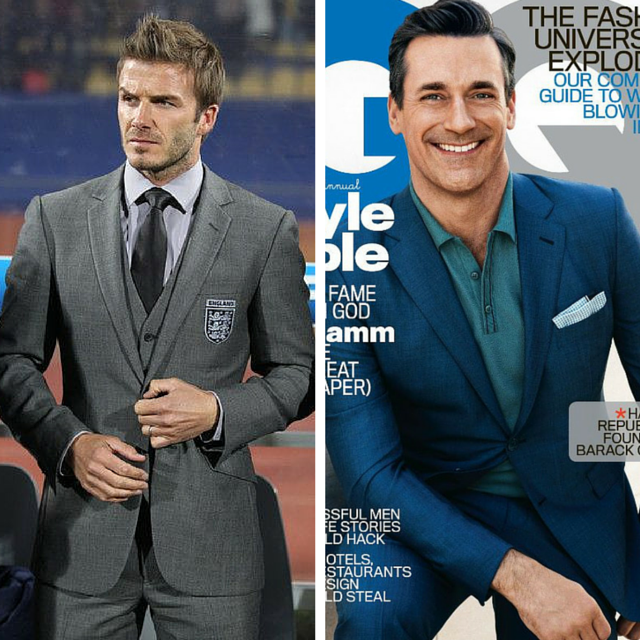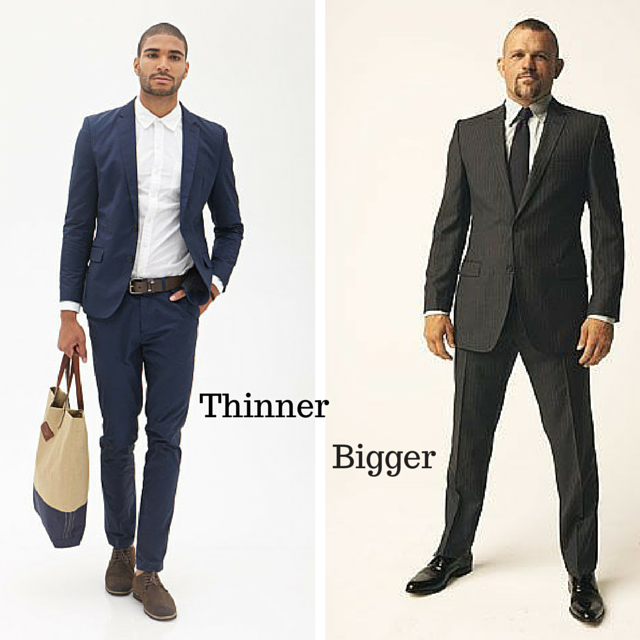This weeks post is inspired by two things – firstly the many responses to last weeks introduction to relaxed trim discussion; and secondly by two guys I saw on Monday as I was walking to a fitting downtown.
No question over the last decade and a half the menswear game has changed dramatically. I point to the rise of David Beckham as a fashion icon and the impact of men’s magazines such as GQ and Details in the early 2000’s as the driving forces behind this change.
Coupled with the recent emergence of social media and a new monster was born – on more traditionally found in womenswear. I’m talking about the emergence of trends in the menswear game at a level not seen before; the result being a real narrowing of what is viewed as “on-point” in terms of styling and silhouette. This is why the subtle shift I spoke of last week is so important.
Always dress for your body type.
The starting point that I use for all my clients is that they need to dress for their body type. To do this though one has to be honest in terms of how they assess their body. There are a lot of styles that I like out there but the reality of my body means not all of them are attainable. Having this awareness is of course easier said than done – something which has become even more difficult with the narrowing view of what is “on-point”. As a result I see far too many guys trying to pull off styling that isn’t suited for their body type.
This point was hammered home for me on Monday as I walked along Burrard from Hastings towards Dunsmuir. Apologies for no photos but I couldn’t bring myself to ask or take a shot without permission. The first guy was dressed casually and absolutely on-point from a style perspective – an untucked navy button-up shirt with the sleeves perfectly rolled, beige chino’s and white sneakers sans socks. Not a lot different from this guy who the Sartorialist shot in Milan a few years back:
Where it went wrong though was in the proportions. He was a heavier set guy – particularly in the mid section (re. belly and seat). The pants were extremely tapered and “stylishly” rolled well above the ankle in keeping with a J Crew advertisement. The problem was that the taper and roll enhanced the size of his mid section to the point that the stylishness of the look was irrelevant.
The second scenario also involved a very well put together guy who like the first is very aware of what looks are trending right now. He had a very athletic build – probably in the 6 ft 2″, 210 pound range and very cut. The proportions of his suit were dead-on for his frame as he didn’t go too slim – he went to the edge but not over. I could tell this was the case as he had very developed calves and I could see that the pant was as trim as it could go without catching on them. Where did he go wrong then? He got caught up in the trend game and cut the pants way too short. Due to his size the pants at the bottom had too much width to cut short – they were wildly flopping around as he walked which took a great suit and made it look comical.
The image above is a classic example of rail thin versus athletic and bigger. The short and trim look works great with a thin body type but a bit more length and width is required for a bigger body.
Be honest with yourself.
In both cases these guys did almost everything right. Their only mistakes were not adapting the looks to their body types. Keep in mind that all models are tall and rail thin; this body type that designers and the fashion machine at large use as their baseline. A recent J Crew brochure listed the models height and weight as a guide for fit – in this case he was 6 ft 2″ and 165 pounds. I’m not sure about you but I don’t know too many guys that rail thin. I’m less an inch and have 20 pounds on that guy – I’ll never be able to wear things in the same way as him. It doesn’t matter how much you like the look – every time you need to assess if it works for your body type. And when doing so be honest with yourself.
How to adapt.
As I said before all of these styles are designed with the tall and thin in mind. Short and thin – you can get away with it. If you’re medium in build you’re also likely to be fine irregardless of height. Where things need to get tweaked is if you have muscles or are carrying a bit of extra weight; a boat which holds most of us. Here are a few keys to keep in mind.
1. Fluidity
When you’re not rail thin and devoid of muscle mass it is crucial that your clothes fluidly move and interact with your body. Every time we move our muscles expand and our body mass reacts in some way. The fit of our clothing needs to reflect this fact otherwise it will catch and pull. These stress marks never look good despite how slimming the effect might be when you’re not moving!
2. Know how your clothes respond on your body.
I’ll admit this is a bit of a difficult one – I’ll explain using my seat as the example. After years of squats I have a pretty developed seat – particularly in the upper seat area. Further to that my root foot is dominant and through years of sport my right seat has ended up being more developed than my left. Still with me?
This means a few things. The first being my pant waist is driven upwards at the back due to my developed upper seat. It is worse on the right side as its pushed even higher – this leads to the waistband sitting on awkward and uncomfortable angle. As a result a low waisted pant is out the question for me despite the fact that I like the style of the look. Why? It rests on the upper seat level and hence it moves with every step I take. The solution is a higher sitting pant that enables more fullness over the upper seat area and reduces any excess movement in the waistband itself. This is both more comfortable and looks better as it allows for a more fluid transition over the seat.
The take-away – comfort and the realities of your body will dictate what type of looks you can and cannot go for. Always let your body dictate and you’ll be fine.
3. Don’t do it.
Some basic rules to guide you with two of the most popular looks these days –
- Tapered Pants – If you have a big mid section – particularly in the seat area – then your taper in the pant leg has to be subtle. Too much and it simply visually enhances the size of your seat which is obviously not the look you’re going for.
- Cropped Pants – If you’re going to go with the short cropped pant look make sure the width of your pant bottom is less than 15″ at a minimum. Any bigger and it will flap as you walk and look comical. Depending on your seat and quad size dropping into the 14″ range is absolutely fine. Keep in mind that it needs to be proportional with the size of your shoe – the bigger the shoe the more width you need.
- Just to be clear – if you put the top two together it means that if you’re not very thin you probably shouldn’t be going for the skinny and cropped look. Thinner and shorter are fine – play with the width and length to find out what works for your body type. Chances are it will be a bit of trial and error.
- And lastly – a jacket should never have stress lines emanating from the button closure. Somewhere along the way in certain circles this has become viewed as an indicator of a good slim fit jacket – it’s not.
As always let me know what you think – your comments are always valued and guide me in what subject matter I will discuss next. Don’t hesitate to book a free appointment today and we can discuss these matters in person – I look forward to hearing from you. Take care,
Michael
info@martinfishertailors.com


![GC[1]](http://www.martinfishertailors.com/wp-content/uploads/2015/06/GC1.jpg)




